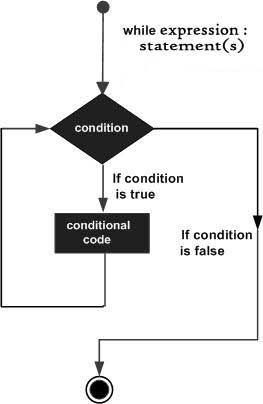实例
#!/usr/bin/python
count = 0
while ( count < 9 ) :
print ' The count is: ' , count
count = count + 1
print " Good bye! "
count = 0
while ( count < 9 ) :
print ' The count is: ' , count
count = count + 1
print " Good bye! "
运行实例 »
以上代码执行输出结果:
The count is: 0 The count is: 1 The count is: 2 The count is: 3 The count is: 4 The count is: 5 The count is: 6 The count is: 7 The count is: 8 Good bye!
while 语句时还有另外两个重要的命令 continue,break 来跳过循环,continue 用于跳过该次循环,break 则是用于退出循环,此外"判断条件"还可以是个常值,表示循环必定成立,具体用法如下:
# continue 和 break 用法
i = 1
while i < 10 :
i += 1
if i % 2 > 0 : # 非双数时跳过输出
continue
print i # 输出双数2、4、6、8、10
i = 1
while 1 : # 循环条件为1必定成立
print i # 输出1~10
i += 1
if i > 10 : # 当i大于10时跳出循环
break
i = 1
while i < 10 :
i += 1
if i % 2 > 0 : # 非双数时跳过输出
continue
print i # 输出双数2、4、6、8、10
i = 1
while 1 : # 循环条件为1必定成立
print i # 输出1~10
i += 1
if i > 10 : # 当i大于10时跳出循环
break
无限循环
如果条件判断语句永远为 true,循环将会无限的执行下去,如下实例:
实例
#!/usr/bin/python
# -*- coding: UTF-8 -*-
var = 1
while var == 1 : # 该条件永远为true,循环将无限执行下去
num = raw_input ( " Enter a number : " )
print " You entered: " , num
print " Good bye! "
# -*- coding: UTF-8 -*-
var = 1
while var == 1 : # 该条件永远为true,循环将无限执行下去
num = raw_input ( " Enter a number : " )
print " You entered: " , num
print " Good bye! "
以上实例输出结果:
Enter a number :20 You entered: 20 Enter a number :29 You entered: 29 Enter a number :3 You entered: 3 Enter a number between :Traceback (most recent call last): File "test.py", line 5, in <module> num = raw_input("Enter a number :") KeyboardInterrupt
注意:以上的无限循环你可以使用 CTRL+C 来中断循环。
循环使用 else 语句
在 python 中,while … else 在循环条件为 false 时执行 else 语句块:
实例
#!/usr/bin/python
count = 0
while count < 5 :
print count , " is less than 5 "
count = count + 1
else :
print count , " is not less than 5 "
count = 0
while count < 5 :
print count , " is less than 5 "
count = count + 1
else :
print count , " is not less than 5 "
以上实例输出结果为:
0 is less than 5 1 is less than 5 2 is less than 5 3 is less than 5 4 is less than 5 5 is not less than 5
简单语句组
类似 if 语句的语法,如果你的 while 循环体中只有一条语句,你可以将该语句与while写在同一行中, 如下所示:
实例
#!/usr/bin/python
flag = 1
while ( flag ) : print ' Given flag is really true! '
print " Good bye! "
flag = 1
while ( flag ) : print ' Given flag is really true! '
print " Good bye! "
注意:以上的无限循环你可以使用 CTRL+C 来中断循环。























 1417
1417











猜大小的游戏
猜拳小游戏
测试结果:
摇筛子游戏
十进制转二进制
while循环 - 九九乘法表